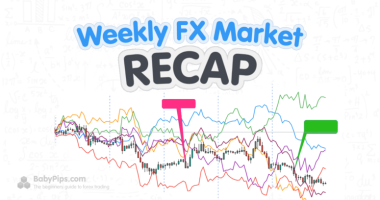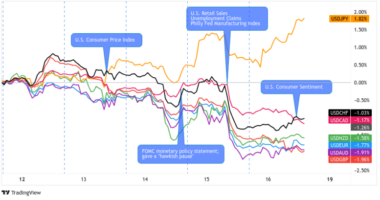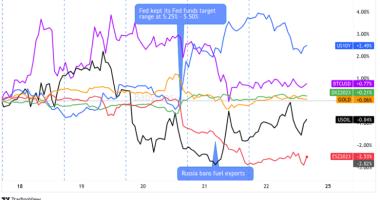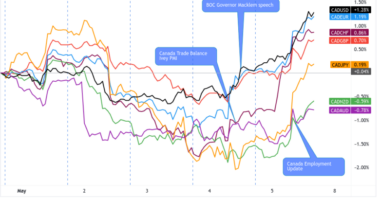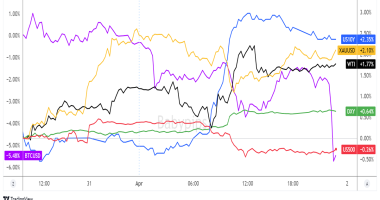The Aussie dollar takes the top spot this week despite a bearish reaction to a surprise move from the Reserve Bank of Australia.


Australian Headlines and Economic data
Monday:
Australia PMI: Output growth accelerates, purchasing activity & employment rise
“The seasonally adjusted IHS Markit Manufacturing Purchasing Managers’ Index rose from 55.7 in December to 57.2 in January”
“Output growth accelerated to the fastest in just over three years as the economic recovery gained traction, the rate of increase far outpacing anything seen over the prior six months of recovery from the initial impact of the coronavirus disease 2019 (COVID19) lockdowns.”
“Inventories of both inputs and finished goods meanwhile rose to the greatest extents since the pandemic despite the shortages of inputs, as firms sought to rebuild stock levels and refill warehouses to meet future demand.”
Tuesday:
RBA kept interest rates and policy unchanged as expected
“The recovery is expected to continue, with the central scenario being for GDP to grow by 3½ per cent over both 2021 and 2022. GDP is now expected to return to its end-2019 level by the middle of this year.”
“In underlying terms, inflation is expected to be 1¼ per cent over 2021 and 1½ per cent over 2022.”
“The Board will not increase the cash rate until actual inflation is sustainably within the 2 to 3 per cent target range. For this to occur, wages growth will have to be materially higher than it is currently. This will require significant gains in employment and a return to a tight labour market. The Board does not expect these conditions to be met until 2024 at the earliest.”
Australia’s central bank will extend its quantitative easing program by a further A$100 billion ($76.2 billion) and doesn’t expect to increase interest rates until 2024 – this was likely the catalyst for the Australian dollar’s fall during the Tuesday session. There were no expectations that the RBA would extend the quantitative easing program beyond April.
Wednesday:
RBA Gov. Lowe: Australia will need ‘very significant monetary support’ for years
Australia building approvals spike in December – “The total number of building permits issued in Australia jumped a seasonally adjusted 10.9 percent on month in December, the Australian Bureau of Statistics said on Wednesday – coming in at 19,537.”
AU construction industry recovery strengthens into 2021
“All four components of activity expanded strongly in December 2020 and January 2021 “
“The new orders index surged to 58.6 points, its highest level since March 2018, which bodes well for building activity over the next three to six months.”
RBA’s Lowe hails QE, warns on premature stimulus withdrawal – “The bond-purchase program has helped to lower interest rates and has meant that the Australian dollar is lower than it otherwise would have been,” Lowe said in a speech Wednesday. “In terms of the most important consideration — the outlooks for inflation and jobs — we remain well short of our goals.”
Thursday:
Australian NAB quarterly business index up from -8 to +14
““The bond-purchase program has helped to lower interest rates and has meant that the Australian dollar is lower than it otherwise would have been,” Lowe said in a speech Wednesday. “In terms of the most important consideration — the outlooks for inflation and jobs — we remain well short of our goals.””
Australian trade surplus widened from 5.01B AUD to 6.79B AUD
Australia’s exports up 3% in December 2020 vs. 6% forecast -“Australia’s trade surplus rose to a six-month high in December as iron ore exports to China easily weathered diplomatic squalls between the two countries.”
Friday:
Australia’s sales boost services sectors over summer holiday period – “The Australian Industry Group Australian Performance of Services Index (Australian PSI®) rose by 1.4 points to 54.3 over the summer holiday period (December 2020 and January 2021*), indicating a further improvement in conditions following the COVID-19 recession of 2020”
RBA Gov. Lowe: rates will remain low for “quite a while yet”
RBA sets out three scenarios for outlook – BASELINE SCENARIO – This assumes no further large outbreaks of COVID-19 and hard lockdowns within Australia and restrictions, when imposed, are brief. The domestic vaccination program proceeds in line with government guidance and the international border remains closed until the end of 2021. Economic growth is expected to contract around two per cent over the year to December 2020 but then grow about 3.5 per cent over both 2021 and 2022. Unemployment will be 5.25 per cent by mid-2023, compared with 6.6 per cent now.





